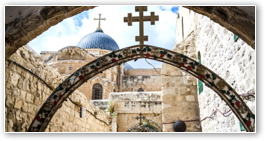The wrong side of the fence
- FATHER RAYMOND J. DE SOUZA
The new Israeli government elected on Tuesday is expected to embrace unilateral disengagement to separate, metaphorically and literally, Israelis and Palestinians.
 |
That this happened on the same day the Hamas cabinet was approved by the Palestinian Legislative Council was a neat coincidence, as Hamas represents exactly what Israel wants to separate itself from. That separation has consequences not only for Jews, but Christians too.
The icon of the policy is the eponymous separation barrier, which was recently described by Irshad Manji in these pages as “birthed by shaheeds, suicide bombers whom Palestinian leaders have glorified as martyrs.” I toured the security barrier last week. For most of its 726 kilometres, it consists of a series of fortified fences. But here in Jerusalem, one sees the towering concrete walls that make up the 5% that winds through urban areas.
To behold the barrier is to weep; it is an ugly scar ripped across the face of a holy land. A scar is the apt image, for this same land has been grievously wounded by bloody terror attacks. Deep wounds do not heal without leaving traces, and the security barrier is the scar that marks the closing of the wounds inflicted by the suicide bombers of the second intifada. A scar is better than a bleeding wound, but it still disfigures.
While most Israelis support the barrier and the larger policy of which it is a part, there is lively dis agreement about its exact route and its impact on Palestinians. Official Israeli statements speak of the barrier as “temporary” — i.e., until the threat of terrorism subsides — though at a cost of US$2-billion, one expects it is not coming down anytime soon. As for its effectiveness, since the barrier has gone up terror attacks have been dramatically reduced.
Manji is right: The barrier is a consequence of suicide attacks. She also notes what is obvious: that it causes pain and humiliation to the Arabs on the other side. It is the logic of suicide bombing — a targeted nation cannot rely on apprehension, only prevention — that demands that the innocent must be kept at bay with the guilty. But the question arises: From where did suicide bombing come?
The first intifada of the 1980s was a nationalist uprising, with Palestinians for the most part directing their protests and violence against the occupying forces rather than civilians. The juxtaposition of rock-throwing boys and the mighty Israeli army convinced many both within and outside Israel that ruling over the territories was an impossible task. In time, it set the stage for the Oslo accords and the creation of the Palestinian Authority.
The second intifada was different. Terrorism was the favoured tactic, and suicide bombing the favoured technique. Something had changed, because suicide bombing is not born from Arab nationalism. It is an Islamist phenomenon. There are no Christian Arab suicide bombers. |
The second intifada was different. Terrorism was the favoured tactic, and suicide bombing the favoured technique. Something had changed, because suicide bombing is not born from Arab nationalism. It is an Islamist phenomenon. There are no Christian Arab suicide bombers.
What happened between the first and second intifada was the Islamification of the Palestinian cause. Toward the end of his life, Yasser Arafat began to adopt more militant Islamic rhetoric and imagery. The election of Hamas, an explicitly Islamist terrorist movement, confirmed the degree to which religiously-inspired extremism, rather than national aspirations, now animate the Palestinian cause.
This is deeply troubling for Palestinian Christians. Israel can separate itself from the shaheeds. The 30,000 Christians living in the West Bank and Gaza cannot. It is possible for Christians to support the Palestinian national struggle; indeed, worldwide, most Christian leaders do. But it is not possible for Christians to support an Islamist movement.
Christians in the Holy Land know this. The original route of the security barrier would have cut off the Christian shrines of Bethany (where Lazarus was raised from the dead) from Israeli-controlled Jerusalem. While opposing the barrier in principle, the custodians of the shrines argued successfully to be put on the Israeli side of the barrier. That makes sense for the sake of pilgrims coming from Jerusalem, but was also motivated by a desire not to be under an Islamist thumb.
Bethlehem , which once had an Arab Christian majority, is now three-quarters Muslim. It was only a few years ago that the Church of the Nativity was used as an armed refuge by Palestinian fighters. That desecration took place under Arafat’s Fatah-dominated regime. How will Christian holy sites and pilgrims fare under Hamas?
Memories outside the Holy Land are short, but it is remembered here that Jewish holy sites did not fare well under the Jordanian Arab Legion, which controlled the Old City and the Mount of Olives from 1948 to 1967. The Jewish Quarter was razed, the most sacred synagogue blown up (it is only now being rebuilt), the cemeteries desecrated, and access to the Western Wall blocked.
Ironically, the Israeli separation barrier — in principle antithetical to the idea of pilgrimage — may secure Christian and Jewish holy sites for pilgrims to Jerusalem and Israel itself. On the Hamas side of the barrier, there is good reason to worry.
 This is Meaghen Gonzalez, Editor of CERC. I hope you appreciated this piece. We curate these articles especially for believers like you.
This is Meaghen Gonzalez, Editor of CERC. I hope you appreciated this piece. We curate these articles especially for believers like you.
Please show your appreciation by making a $3 donation. CERC is entirely reader supported.

Acknowledgement
Father Raymond J. de Souza, "The wrong side of the fence." National Post, (Canada) March 30, 2006.
Reprinted with permission of the National Post and Fr. de Souza.
The Author
Father Raymond J. de Souza is the founding editor of Convivium magazine.
Copyright © National Post

